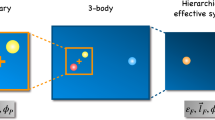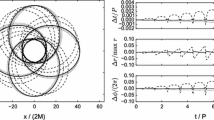Abstract
The micro-canonical phase-space volume for the three-body problem is an elementary quantity of intrinsic interest, and within the flux-based statistical theory, it sets the scale of the disintegration time. While the bare phase-volume diverges, we show that a regularized version can be defined by subtracting a reference phase-volume, which is associated with hierarchical configurations. The reference quantity, also known as a counter-term, can be chosen from a 1-parameter class. The regularized phase-volume of a given (negative) total energy, \({{\bar{\sigma }}}(E)\), is evaluated. First, it is reduced to a function of the masses only, which is sensitive to the choice of a regularization scheme only through an additive constant. Then, analytic integration is used to reduce the integration to a sphere, known as shape sphere. Finally, the remaining integral is evaluated numerically and presented by a contour plot in parameter space. Regularized phase-volumes are presented for both the planar three-body system and the full 3d system. In the test mass limit, the regularized phase-volume is found to become negative, thereby signaling the breakdown of the non-hierarchical statistical theory. This work opens the road to the evaluation of \({{\bar{\sigma }}}(E,L)\), where L is the total angular momentum, and in turn to comparison with simulation determined disintegration times.






Similar content being viewed by others
Notes
Whenever the reader is unsure about whether we are using the (original) position variables (r) or the rescaled position variables \(({{\tilde{r}}})\), the appropriate factors of Energy (|E|) can be reinstated by dimensional analysis.
We get the first equality by multiplying the third row by \(\frac{m_3}{M}\), then adding to it \(\frac{m_1}{M}\) times first row plus \(\frac{m_2}{M}\) times second row.
References
Agekyan, T.A., Anosova, Zh.P., Orlov, V.V.: Decay time of triple systems. Astrophys. 19, 66 (1983) (Translation of Astrofizika 19, 111 (1983). https://doi.org/10.1007/BF01005813)
Agekyan, T.A., Anosova, Z.P.: A study of the dynamics of triple systems by means of statistical sampling. Astron. Zh. 44, 1261 (1967)
Ginat, Y.B., Perets, H.B.: An analytical, statistical approximate solution for dissipative and non-dissipative binary-single stellar encounters. Phys. Rev. X 11, 031020 (2021). https://doi.org/10.1103/PhysRevX.11.031020
Kol, B.: Natural dynamical reduction of the three-body problem. (2021a) arXiv:2107.12372 [astro-ph.EP]
Kol, B.: Flux-based statistical prediction of three-body outcomes. Celest. Mech. Dyn. Astron. 133, 17 (2021b). https://doi.org/10.1007/s10569-021-10015-x. [arXiv:2002.11496 [gr-qc]]
Lemaître, G.: Coordonnées symétriques dans le problème des trois corps. Ext. Bull. Acad. R. Belg. 120, 582 (1952)
Manwadkar, V., Trani, A.A., Leigh, N.W.C.: Chaos and Lévy flights in the three-body problem. Mon. Not. R. Astron. Soc. 497, 3694 (2020). https://doi.org/10.1093/mnras/staa1722
Manwadkar, V., Kol, B., Trani, A.A., Leigh, N.W.C.: Testing the flux-based statistical prediction of the three-body problem. Mon. Not. R. Astron. Soc. 506, 692 (2021). https://doi.org/10.1093/mnras/stab1689
Moeckel, R., Montgomery, R.: Symmetric regularization, reduction and blow-up of the planar three-body problem. Pac. J. Math. 262, 129 (2013)
Monaghan, J.J.: Statistical-theory of the disruption of three-body systems: I. Low angular momentum. Mon. Not. R. Astron. Soc. 176, 63 (1976)
Montgomery, R.: The three-body problem and the shape sphere. Am. Math. Month. 122, 299 (2015)
Newton, I.: Philosophiæ Naturalis Principia Mathematica (1687)
Poincaré, H.: Sur le problème de trois corps et les équations de la dynamique. Acta Math. 13, A3 (1890)
Stone, N.C., Leigh, N.W.C.: A statistical solution to the chaotic, non-hierarchical three-body problem. Nature 576(7787), 406 (2019). https://doi.org/10.1038/s41586-019-1833-8
Valtonen, M.J., Karttunen, H.: The Three-Body Problem. Cambridge University Press, Cambridge (2006)
Valtonen, M.J., Anosova, J., Kholshevnikov, K., Mylläri, A., Orlov, V., Tanikawa, K.: The Three-body Problem from Pythagoras to Hawking. Springer, Berlin (2016)
Acknowledgements
Part of this research was supported by the Israel Science Foundation (Grant No. 1345/21). The work of S.M. was supported by the National Research Foundation of Korea grant NRF-2019R1A2C2084608. S.M. would like to thank the organizers of both ‘New Frontiers in Quantum Field Theory and String Theory’ and ‘Advances in Theoretical Physics 2022’ workshops for hospitality while this work was in progress.
Author information
Authors and Affiliations
Corresponding author
Additional information
Publisher's Note
Springer Nature remains neutral with regard to jurisdictional claims in published maps and institutional affiliations.
Appendices
A Compensator evaluation
In this appendix, we detail the evaluation of the compensator (35). In fact, we provide two derivations.
The first way involves a reflection symmetry
The second way involves a direct integration with a convenient ordering of the three integrations
where in passing to the fourth line, we have changed variables according to \(u^2=2 u_B-1\).
B Planar reduction
In this appendix, we derive (36). We start with the following rewriting of the LHS:
Next, we express \(dz_1\) and \(dz_2\) in terms of rotations in the \(x-y\) plane
where \(d\vec \phi \) is an infinitesimal vector in the \(x-y\) plane. Since
we have
Area of the triangle formed by the three bodies is given by the determinant
which can be reduced using the following stepsFootnote 2
Substituting (75) in (69), we get
where we rewrite \(\hbox {d}\phi _x\hbox {d}\phi _y\) as \(\hbox {d}\Omega \), which is the differential solid angle on the unit sphere. We have thus derived (36).
C Expressions for potential and triangle area
In this appendix, we derive the expressions for A, V in terms of \(r,\theta ,\phi ,\psi \) coordinates. For this, we need the expressions for the relative distances between the three bodies, i.e., \(r_{12},r_{13},r_{23}\). First, we express them in terms of w variables defined in (38)
where we use the following notation: \(\eta =e^{j\frac{2\pi }{3}},~{\bar{\eta }}=e^{-j\frac{2\pi }{3}},~\bar{w}=w/.\{j\rightarrow -j\}\) and the absolute values are calculated with respect to i. Using (42), we rewrite in terms of \(r,\theta ,\phi ,\psi \) coordinates
From (78), it is straightforward to derive expression for V in (46).
To derive the expression for A in (45), we use the formula
Rights and permissions
Springer Nature or its licensor (e.g. a society or other partner) holds exclusive rights to this article under a publishing agreement with the author(s) or other rightsholder(s); author self-archiving of the accepted manuscript version of this article is solely governed by the terms of such publishing agreement and applicable law.
About this article
Cite this article
Dandekar, Y., Kol, B., Lederer, L. et al. Regularized phase-space volume for the three-body problem. Celest Mech Dyn Astron 134, 55 (2022). https://doi.org/10.1007/s10569-022-10108-1
Received:
Revised:
Accepted:
Published:
DOI: https://doi.org/10.1007/s10569-022-10108-1




